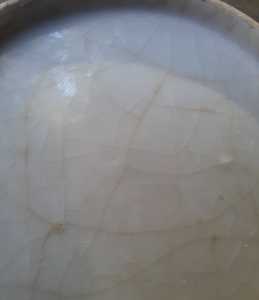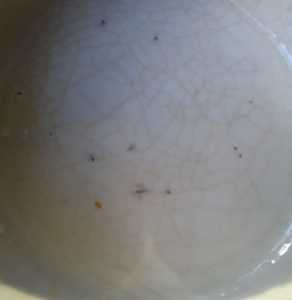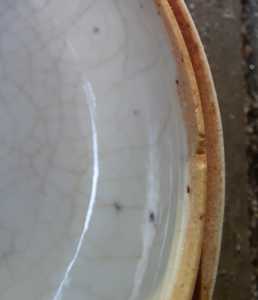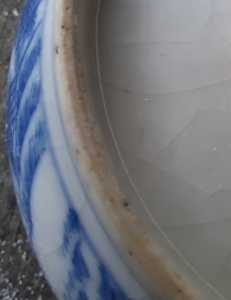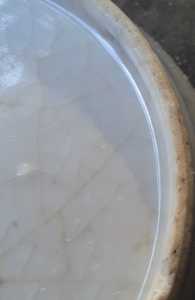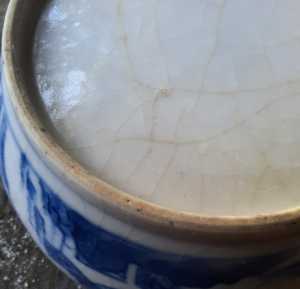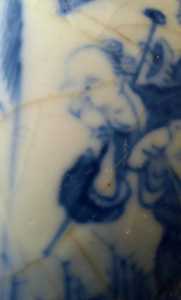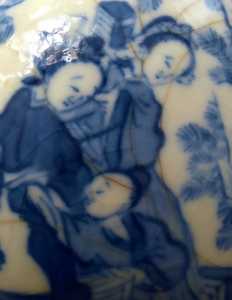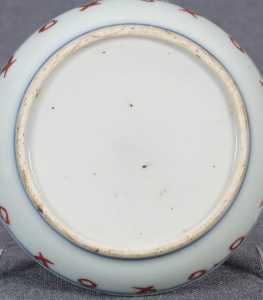The Chinese and Asian Art Forum. For Fans, Collectors and Dealers.
 Basic Rules For the BidAmount Asian Art Forum: Talk about whatever you want. You can even discuss and offer things that are for sale if they are authentic. Maximum image file size per post is 2 MB. Images of 700pxl x 700pxl are optimal if saved at a medium resolution. Be respectful of others and enjoy yourself. Click the YouTube link for a brief tutorial on using the forum. You can also EMBED Videos by cutting and pasting from You-Tube, Vimeo etc.
Basic Rules For the BidAmount Asian Art Forum: Talk about whatever you want. You can even discuss and offer things that are for sale if they are authentic. Maximum image file size per post is 2 MB. Images of 700pxl x 700pxl are optimal if saved at a medium resolution. Be respectful of others and enjoy yourself. Click the YouTube link for a brief tutorial on using the forum. You can also EMBED Videos by cutting and pasting from You-Tube, Vimeo etc.
NOTE: To post an item or add a new post, click open the category title from the FORUM LIST, and CLICK the Blue ADD TOPIC button.
@greeno107 Have you posted a side shot of the box to show its shape/profile?
Assuming (from the theme) it was made for a domestic audience and not European export, there's a much wider range of kilns, materials, styles, degrees of quality etc. to consider. Normally when we talk about Kangxi ceramics being this or that way, we're talking about Kangxi ceramics for export to the West, typically JDZ wares. But the domestic (and SE Asia export) markets were always a more vibrant hodgepodge of provincial kilns, sometimes with great artists, often with subpar materials and very old-school methods.
At first glance I thought it was a very nice "minyao" box from the late 18th early 19th Cs, because the paste looked grayer and less refined, like kitchen Qing.
Anyway, nice piece! I hope we learn more.
@craig Sure, I can post a side shot. Give me a minute.
Meantime, I retook a few photos. One photo shows the faces in better light, closer up, and high resolution. Also, I'm including photos of the foot rim, inner unglazed mouth, glazed inside of the box, and glazed bottom.
Keep in mind that the reddish color on the unglazed mouth of the box is an external impurity...I just have not had the time to clean it off.
Just to be clear - I do not disagree that complexity of the scene seems a step beyond what is shown in Kangxi works. My original thought was that maybe earlier Kangxi ware, or Shunzi wares might be more detailed, but I was wrong - as you can see from the great chronological photos provided by Stewart.
In reviewing some Western Chamber examples made during the Yongzheng blue & white's seem to be more complex, and perhaps this is a possibility, but I as of yet I can't find a single round box example of the Yongzheng to compare.
Design wise, the more logical assumption would be that it is late 19th c., but the paste seems older. And,while Giovanni feels they could be mid 19th c., again, in looking for anything comparable...sadly, nothing comes up.
In Giovanni's defense (not that he needs any), Jingdezen porcelain snuff bottles from the first half to mid 19th c. that depict Western Chamber themes do seem to have some similarity, but these snuffs seem to have more in common with the limited detailed figures of actual Kangxi designs, and in the end, I'm back in the same spot... my box seems too detailed. Larger blue and white porcelain examples (vases, plates, bowls) from the early to mid 19th c. do not seem to be made in any style similar to my box.
Anyway, here are some more pics...I'll get a photo of the profile of the box soon.
Dear Greeno, each own with his personal opinion, you are of course free of thinking as you want.
But frankly, thinking that your box could be even 17th century, when the style of painting is of a completely different manner, and when soft paste porcelain didn’t exist, being started in the 18th century, it doesn’t make much sense.
The figures of the 17th century are immediately recognizable, even if all the other factors of the piece are missed. Please look at the figures of the 17th century, they are very typical.
We all have our personal ideas, depending from our experience and knowledge. My experience and knowledge are excluding the possibility that your box has been made during Kangxi. Paste, glaze and painting style are not as they should be. Three reasons for excluding that. You can think different, but the evidence is there. I am posting here the base view of an original Kangxi paste box like your one, that I had sold on eBay. You can see the difference of paste and glaze of your one.
I have never said that your box is of a certain date. I said that I think that it should be about half of 19th century because it is not Kangxi as you think and because soft paste was more commonly in use on small objects. It has been a mere judgement based on probabilities; it could also be of very beginning or either late 19th century, but for sure not Kangxi.
You could send the pictures to Christie’s if you are convinced that it is Kangxi or even 17th century.
As for Kangxi revival, the definition has been made for identifying Guangxu ware that are imitating as close as possible the originals. If a b&w jar that is clearly 19th C. or later should be identified as Kangxi revival only because it is carrying an apocryphal Kangxi mark, then a Kangxi bowl bearing the apocryphal Xuande mark should be called “Xuande revival”?
I am against the not correct use of terminology, it is disguising.
It is not right that a 19th century pot, or even much modern as it happens to see, is called famille verte only because it has some green. That is ridiculous. The definition has been made well after Kangxi for identification of a well-defined type of ware, mainly Kangxi. It is ridiculous to call famille verte a much later item, unless it is copying in all its features an original famille verte one, as it is often seen in real Kangxi revival.
I would not call the following item Famille noire (sorry dear Martin):
It has nothing to do with the type of ware for which the definition has been made.
Regards,
Giovanni
My original thought was that maybe earlier Kangxi ware, or Shunzi wares might be more detailed, but I was wrong - as you can see from the great chronological photos provided by Stewart.
Dear Greeno, I see now, after having posted my previous message, that you changed your opinion about the possibility of being the box even earlier. As a side note, I had an identical dish of the on eseen in the third imag eposted by Stuart. That one and my previously owned one arew the only two that I am aware of.
Regrettably sold!
Please send this to Peter and see what he says then let us know. I still think late Kangxi/Yongzheng/early Qianlong seems possible.
@clayandbrush Thank you for acknowledging that I conceded my original thinking during previous posts that the box could be an earlier than Kangxi.
Yes, we can (and should) have members participating with varying opinions, and given the absence of a time machine, sometimes we just need to agree to disagree. I like chess and have played since I was about 5 years old...so quite some time. I enjoy playing beginners to help them learn, but the real enjoyment comes from playing someone better than me... so game on!
Ironically, Christie's wrote to me today to ask what I might have for the fall sale, but to be honest, I do not like to make requests to them to act as referee to what I think is a perfectly legitimate discussion between you and I. The same goes for contacting Peter - I value his opinion, and if he wants to chime in, he is welcome, but only if he wants to contribute on equal footing as you, me, or anyone else for that matter.
You asked if I thought a Kangxi bowl bearing the apocryphal Xuande mark should be called “Xuande revival” - No. Apples and oranges. As you know, during the Kangxi there was no time period of renewed interest in Xuande ware, and the use of the mark had to do with the restrictions placed upon using Kangxi marks.
Apocryphal marks pay homage, or perhaps could be considered commemorative, but that does not mean that during the period made that there is a revival taking place, and nor does it exclude it. It depends on the time in which the mark was used, but I'll explain this further in just a moment.
As for your suggestion that by my definition of 'revival' that somehow I am suggesting that a green vase could be considered famille verte simply on the merits of its color is completely ridiculous. In fact, I made very clear that 'revival' wares were determined by the time period made, not the manor/quality of the decor - that actually seems to be your position, and an incorrect one.
You are entitled to set your quality thresholds as high as pleases you with regards to what you want to purchase/sell as 'Kangxi revival'. But, no matter the appearance, I can guarantee that any 'Kangxi revival' porcelain you encounter will have been made during the late 19th c. That is because the 'revival' is a reference of time, not quality, when a particular old style becomes popular again.
The term 'revival' is not a matter of opinion or semantics. It is a factual term that is defined, according to Oxford Dictionary, as "an instance of something becoming popular, active, or important again." To clarify, "an instance", is a measurement of time.
Let's take a trip back to the late 19th c. in China. The quality during the Guanxu compared to earlier Qing wares ... not so great. However, there were some nice Imperial wares and domestic wares that certainly are worthy of collecting. So, it is reasonable to say that during the late 19th c., there were kilns capable of producing high quality, but perhaps the majority of the kilns during the Guangxu produced low quality wares predominantly to sell to Europeans.
The 'Kangxi revival' occurs along side other revival periods that were taking place in Europe...Egyptian, Greek, Gothic... Why? Because Europeans were traveling and bring back antiquities at a pace never seen in earlier periods, and as the popularity of these antiquities grew, so did the value of these antiquities. Not everyone could afford the real thing.
Artisans saw the opportunity to cash in and began to copy the styles, some better than others, and some incorporated old styles into contemporary designs creating completely new and unique designs (a blend of old and new). This was true for architecture, textiles, paintings, music, and yes, Chinese porcelains.
So, why did the Chinese settle on a Kangxi revival and not a Yongzheng revival (or some other period)? I'm not sure I can answer that (I don't know), but I think it probably had to due with the interest of Europeans in blue and white wares, and perhaps Qing artisans were not as well versed in Ming decor as Qing. I could argue that 'Kangxi revival' extended into all porcelains famous during the Kangxi (monochromes, famille verte, blanc de chine), but for the sake of creating a novel (which I kind have already done), I'll stick to the discussion of blue & white.
In any case, every kiln in China wanted to cash in selling what was popular, and since antiquity was popular among Europeans, naturally they wanted to contribute, and thus a revival was born!
Some high quality kilns likely had well educated artists that were very familiar with Kangxi style, and thus produced exceptionally like copies. Low quality kilns with less knowledgeable artists copied what they knew as best they could, and often incorporated contemporary design/decor to fill in the gaps in their knowledge.
However, for you to say that because a late 19th c. porcelain can not be considered 'Kangxi revival' if it fails to meet the quality of a genuine Kangxi piece in the manner that it is rendered, when it is clear that the artist had made an obvious attempt to copy the Kangxi style during the very period that there was renewed interest in Kangxi style, is to completely change the meaning of the word 'revival'.
Your threshold creates a whole new class of porcelains within an already existing class of porcelains.
You and I are cut from the same cloth in terms of seeking the highest quality possible, and I wish we lived in a world that all 'Kangxi revival' measured to such high standards, but that is not reality, and we can not simply change the meaning of words to suit our personal preferences.
@clayandbrush Just to share, this an very enlightening article on blue and white wares by V&A Museum (You've probably read it).
https://www.vam.ac.uk/articles/chinese-blue-and-white-ceramics/
If you skip towards the end, the article affirms what I've said about the demand for Kangi style blue and white porcelain during the late 19th c., and the crux of what was driving the production (some of which was good, some not so good, but nevertheless, all 'revival').
"Blue-and-white fast became fashionable, not only amongst artists but also within a growing middle class who collected it in order to affirm their artistic, cultivated tastes. Part of its charm was the universally appealing colour combination, mirroring the natural blue and white of the sky and brightening up the typically dark Victorian interior. Antique blue-and-white, particularly from the Kangxi period (1662 – 1722), was also prized for the exquisite skill involved in its pre-industrial manufacture.
By the late 19th century blue-and-white had become an essential element of the 'house beautiful', with sideboards and cabinets being designed specifically for the elegant display of ceramics in the home. British shipping magnate Frederick Richards Leyland went so far as to commission a special room within his Kensington home, with wall supports made specifically to house his collection of blue-and-white porcelain. Designed by Thomas Jeckyll, the Peacock Room was famously redecorated at vast expense by Whistler with an elaborate colour scheme, which he believed would best show off Leyland's collection. The sum Whistler demanded for his interior decorations instigated a life-long feud between the two.
At the height of the blue-and-white craze, Aesthetes like Whistler himself were often ridiculed as suffering from 'Chinamania', valuing their blue-and-white porcelain above all else. By the time he died, Whistler's collection numbered over 300 objects, most of which are now in the Hunterian Museum, Glasgow, while some fine specimens owned by Whistler are on display in the V&A in our British Galleries (Room 123)."
A very interesting discussion.
I agree with much of what Greeno says but to be fair Giovanni said not a green vase but a vase with green enamel on it but not decorated in a famille vert style which is a different thing and in that I agree with him; technically one shouldn't call, say, a blue and white piece, made in the late 19th c, Kangxi revival if the style is not Kangxi style - even if it has a Kangxi mark. However, I feel perhaps that is not necessaril9y a distinction that would have been made at the time by ordinary people lacking the access to information we have, so there may be a crossover area of what Kangxi revival.
Anyway, Rob Michiels has a soft paste box which he describes as Kangxi, it is good to see more of these as I feel I need to learn about soft paste. All I am saying about this is that it is quite different whilst being somewhat similar. I still think yours is much later into the 18th c.
@julia That's a very good example of a round box... very much like mine. Thank you for sharing!
Just to clarify....
Giovanni wrote - "It is not right that a 19th century pot, or even much modern as it happens to see, is called famille verte only because it has some green. That is ridiculous."
Rather than defining the term 'famille verte' in my words, let me defer to Gotheborg.com - "Meaning "the green family". Overglaze enamel decoration on export and Imperial porcelain. Developed during the Ming dynasty from multicolored decorations with tranclucent enamels, applied during secondary firing/s on glazed porcelin. By the end of the 16th century formalized into Wanli wucai - Wanli five color enamels - then further into Kangxi wucai and what now by mostly western scholars is recognized by its French name Famille Verte. The colors are usually red, green, yellow, blue and black. Which name that best describes a certain "five-color decoration" depends on the style of the decoration, where we by "Famille Verte" should assume a Kangxi style and period porcelain shapes and decoration."
To summarize, I agree that the term famille verte encompasses both style of the Kangxi and the specific colors, red, green, yellow, blue, and black. There's no disagreement with me in how this term is defined, but this line of argument was a complete red herring.
So, please excuse my simplification of Giovanni's words regarding my change from a 19th c. pot that 'has some green' to 'a green vase'.
My point is that Giovanni seems to be equivocating 'Kangxi revival' with Famille manner of decoration, as if 'Kangxi revival' is a classification type of decoration. By that standard, if I had the talent, I could create a vase today in blue in white of a scene from the Western Chamber in the perfect manner of the Kangxi, and according to Giovanni, it would be considered 'Kangxi revival'.
Obviously, nothing could be further from the truth, because 'revival' is not about the technical abilities to accurately recreate copies, but rather a period of time of renewed interest in an old style, and that took place a bit more than 100 years ago.
Regarding my round box, Giovanni also seems to feel it does not have enough in common with Kangxi works (or perhaps is not high enough quality) with it's design and execution to be considered Kangxi revival. Seriously? Should I not believe my lying eyes? The design and form seems to scream Kangxi.
In the end, I think the soft paste's tendency to pick up impurities and crazing creates a sense of greater age than actuality, and my own lack of knowledge about soft paste works has led me to think the piece to be much older than it is. In retrospect, the box is likely late 19th c., made during the Kangxi revival. I would love to believe that the box was a rare highly detailed example from late Kangxi / early Yongzheng, or something like that, but I don't really believe in unicorns.
All the best to Giovanni for his great knowledge... he certainly was closer with his dating than I was from the very beginning of this discussion.
Many thanks to all!
@greeno107 I still think Peter could illuminate some things about this for you given his vast experience. He doesn't chime in much here, preferring to let the forum do it's own talking, so I'm sure you realize it is unlikely you will get his opinion by waiting for it. At any rate, if that isn't of interest to you then that is your choice, but I'm just saying, he may have seen more examples over the years than you, which could be helpful to get more clarity. As for me, based on my very limited experience, I use all the help I can get. Maybe those with more experience are less apt or not as in need of expert assistance. But as you yourself have stated recently, we are always learning here, no matter what we already have learned up to this point. The fact that there has been so much debate about this little box to me suggests an additional expert opinion would be as valuable as the $12 fee.
Sorry to anyone following this, I didn't describe the box from RM completely, the revival is missing ( I did change my sentances rather a lot!) but I realise now the description actually just says 19th c anyway. I assumed it meant late 19th c ie revival so I may be wrong with that - I do know one should not simply assume. 😊
Dear Greeno,
It seems that you are taking all this on the personal side. Then I will not go further; I want just make clear some of the things that I meant and that you are reporting in different manner than my meaning, after which, from my side, I will stop here.
First at all, all the examples that I made for explaining my thought were not addressed directly to what you think, but were pure examples. Despite my bad English, I do not think that what I said, for example, regarding a Kangxi bowl bearing a Xuande mark, was meant directly to your thinking. It was clearly an example, not a supposition on what you believe, it was obvious. The same for many other things, that you are commenting as if addressed to yourself.
A clear example is what you said about famille verte. It is more than obvious that I was talking about what is revival and what not, and for that I said that it is not the Kangxi mark that make any b&w item, bearing that mark, worth to be called “Kangxi revival”, as it is not some green that make an item worth to be called “famille verte”. The meaning is obvious to anyone, I think. I even linked to the vase posted by Martin, to make clear what I meant. Instead, you are saying that I am suggesting that you are thinking as such.
It is not possible to discuss something if you take everything on the personal side.
BTW, as for the Kangxi revival, it is not as you think. Michael Vermeer has said many times that the mood happened in that time frame because of Cixi’s passion for Kangxi ceramics. And I trust him.
If it was generated by the European demands as you think, then it would have been more related to Ming b&w than the Qing ones, I think.
And if you do not see the difference between the base of the box that I have posted and that of your one, nor the difference in painting style between your box and Kangxi’s painting style, nor between that of your box and that of the box posted by Julia, (which by chance is more looking Kangxi style than your one, and despite that the seller is not mentioning Kangxi revival) then there is nothing more that I can say.
As I said at the beginning of my post, we all form our ideas based on our personal experience and knowledge. It is all said there.
Regards,
Giovanni
@clayandbrush Giovanni, I would be curious to know if and why you think the artwork doesn't look Yongzheng/early Qianlong, because it seems you have skipped over that timeframe as though it is not possible to be that - all the talk has been about Kangxi. For my own education I'm curious to learn the details of why.
Thanks for visiting "The BidAmount Asian Art Forum | Chinese Art"
If you sell on eBay, or have a shop feel free to post images and descriptions and links.
Check back often for discussion about the latest news in the Chinese art and antique world. Also find out about the latest Asian art auctions at Sotheby's, Christie's, Bonhams and Tajans.
Auction results for: fine porcelain, ceramics, bronze, jade, textiles and scholar's objects. As well as Japanese, Thai, Vietnamese and other Asian cultures.
Thank you,
Peter Combs
Topics and categories on The BidAmount Asian Art Forum | Chinese Art
Kangxi vases, Kangxi dishes and chargers, Kangxi ritual pieces, Kangxi scholar's objects, Qianlong famille rose, Qianlong enamels, Qianlong period paintings, Qianlong Emporer's court, Fine porcelain of the Yongzheng period. Chinese imperial art, Ming porcelain including Jiajing, Wanli, Xuande, Chenghua as well as Ming jades and bronzes.
The BidAmount Asian Art Forum | Chinese Art
A free Asian art discussion board and Asian art message board for dealers and collectors of art and antiques from China, Japan, Korea, Thailand, Cambodia, Vietnam and the rest of Asia. Linked to all of the BidAmount Asian art reference areas, with videos from plcombs Asian Art and Bidamount on YouTube. Sign up also for the weekly BidAmount newsletter and catalogs of active eBay listing of Chinese porcelain, bronze, jades, robes, and paintings.
The art of calligraphy - and for the ancient Chinese it certainly was an art - aimed to demonstrate superior control and skill using brush and ink. Calligraphy established itself as one of the major Chinese art forms during the Han dynasty (206 BCE - 220 CE), and for two millennia after, all educated men were expected to be proficient at it.
The Museum’s collections of Asian art span nearly five millennia and encompass the cultures of China, the Himalayas, India, Japan, Korea, and Southeast Asia. In 2007, the Museum launched an initiative to create dedicated galleries for the collection, beginning with a gallery for the arts of Korea ...
Chinese art is full of symbolism, in that artists typically seek to depict some aspect of a totality of which they are intuitively aware.
China Online Museum is the finest online museum of Chinese art. It features Chinese calligraphy, painting, ceramics, bronzes, carving, and other artworks.
Chinese Ceramics & Works of Art. Overview Upcoming auctions Contacts Auction results ... Christie’s sales of Chinese ceramics and works of art showcase centuries of Chinese history. Held throughout the year in London, New York, Paris and Hong Kong, they attract a wide audience of collectors and connoisseurs vying for pieces as diverse as ...
Explore Asian Art Week. Contact the Specialist Department. Chinese Paintings ... Senior Specialist, Head of Sale. [email protected]. Tel:+1 212 641 5760. Bid in-person or online for the upcoming auction:Fine Chinese Paintings on 10 September 2019 at New York. Bid in-person or online for the upcoming auction:Fine Chinese Paintings on 10 ...
Discover an abundance of must-see art from all corners of a vast continent at Christie’s NY Asian Art Week. From contemporary classical and Chinese paintings to works with exemplary provenance from the Art Institute of Chicago, our Rockefeller Paza galleries will be full of ancient treasures and contemporary masterworks in a salute to the vibrant arts of Asia.
Sold to benefit The Art Institute of Chicago’s Asian Art Acquisition Fund, the sale features 84 lots with a focus on Ming and Qing porcelains, and offers a rare insight into the taste for collecting Chinese ceramics and works of art in the Midwest from the end of the 19th century through the 1980s. Highlights include two Wanli wucai garlic-head vases, a Qianlong mark and period, blue and ...
Specialist, Chinese Paintings, Christie's London Dr Malcolm McNeill is a Specialist in Chinese Paintings at Christie’s, based in London. He previously worked as an assistant curator of the Chinese collections and the Victoria and Albert Museum in London, as a researcher at the British Museum, and as a translator and tour guide at the National Palace Museum in Taipei.
The Christie's Education 2020 Conference: The Chinese Art Market 18 Jun 2019 Christie’s Education is delighted to announce our first international academic conference in Asia which will take place in Hong Kong from 26-27 November 2020 at the Hong Kong Convention and Exhibition Centre and will run in parallel with Christie’s Hong Kong Autumn Auctions.
The summer Chinese Art sale in Hong Kong will feature works of art from several private collections, including Qing porcelains and textile from the collection of the legendary Chinese art dealer A. W. Bahr (1877–1959), fine gilt bronze Buddhist sculptures from an old Hong Kong collection, an East Asian collection of Qing dynasty wine cups and jades, and a Japanese collection of Song ceramics ...
Sotheby's Chinese Works of Art Department holds two auctions each year in London, New York, Hong Kong and Paris.
Chinese Art - View Auction details, bid, buy and collect the various artworks at Sothebys Art Auction House.
With more than 340 Chinese works of art dating from the Neolithic to the Republic periods, highlights of this sale include a selection of Qing Imperial monochromes from the collection of Arnold and Blema Steinberg, early ceramics from the Art Institute of Chicago and Chinese porcelain and works of art from the collection of Henry Arnhold.
Results: Sotheby's Asia Week achieved $52.4 million in six strong auctions, exceeding pre-sale estimates. With 76.5% of lots sold and 60.3% of lots surpassing high estimates, the Asian art sales at Sotheby's indicate continued collector interest in the finest works of art from China, India and and the Himalayas.
Today's sale of Important Chinese Art will proceed as planned with sessions at 10 AM and 2 PM EDT. Sotheby's will be monitoring the weather conditions throughout the day and will be available to coordinate alternative bidding options should conditions make it difficult for clients to attend the auction in person.
Bonhams Chinese Art department is renowned for offering the finest works of art representing the richness and breadth of China's artistic heritage, particularly Imperial porcelain, white and spinach green jades, cloisonné and Buddhist art. Specialised international auctions are held globally, including London, Hong Kong and San Francisco.
Bonhams : Chinese Works of Art We use cookies to remember choices you make on functionality and personal features to enhance your experience to our site. By continuing to use our site you consent to the use of cookies. Please refer to our privacy and cookie policies for more information.
Bonhams Fine Art Auctioneers & Valuers: auctioneers of art, pictures, collectables and motor cars. We use cookies to remember choices you make on functionality and personal features to enhance your experience to our site. By continuing to use our site you consent to the use of cookies. ... Chinese Art (US) General enquiries
Bonhams : Fine Chinese Art We use cookies to remember choices you make on functionality and personal features to enhance your experience to our site. By continuing to use our site you consent to the use of cookies. Please refer to our privacy and cookie policies for more information.
Bonhams Fine Art Auctioneers & Valuers: auctioneers of art, pictures, collectables and motor cars Bonhams : Asian Art We use cookies to remember choices you make on functionality and personal features to enhance your experience to our site.
Bonhams are international auctioneers of fine Chinese and Japanese art. We specialise in rare Imperial and Export Chinese ceramics and works of art, as well as Japanese ceramics, fine and decorative works of art from the Neolithic Period to the 20th century. View on map
Bonhams Fine Art Auctioneers & Valuers: auctioneers of art, pictures, collectables and motor cars. We use cookies to remember choices you make on functionality and personal features to enhance your experience to our site. By continuing to use our site you consent to the use of cookies. ... Asian Art Bonhams. Work. 22 Queen St.

